Camping Food List
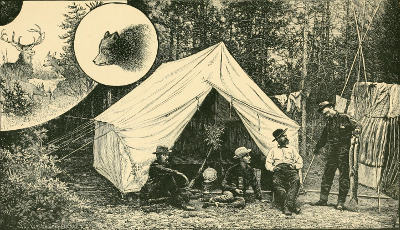
Planning a camping food list can be almost as fun as going on the trip itself. Food can make or break a camping trip, and when it makes it, it can be one of the highlights of your adventure. Creating a camping food list and meal plan prior to heading out, therefore, is not only incredibly useful but can also be an enjoyable way to spend an evening.
Many of those who have arrived at this article are likely already steeped in the planning process. There are some timeless classics with which easily spawn suggestions and generic camping food lists. These will typically look something like this:
• Oatmeal
• Pancakes
• Bacon
• Coffee
• Peanut Butter / Honey
• Mixed Nuts / Trail Mix
• Salami
• Hot Dogs
• Marshmallows
• Hot Chocolate
Valuable wisdom to accompany such a list is to select simple foods which cook quickly and require little preparation.
Although such generic lists bear the merit of trial, I believe some clarification is helpful. There is no end all be all camping food list. For one thing there are too many great foods applicable to consumption in the outdoors to compile into a single list, but more importantly there is more than one kind of camping. The foods you bring with you depend heavily on which kind you will be doing. We can roughly divide camping trips into two major genres: backcountry and frontcountry. We can add more nuance later on.
This is a useful division because the equipment you have access to and the weight you are able to carry inform the decision making process regarding which foods to bring along.
Frontcountry camping is what most people would immediately think of if you mentioned you were going camping. Also known as car camping, frontcountry camping implies that we are near a road, have access to a vehicle, communication, and the associated human infrastructure. Think of a camping trip at your local state park.
Backcountry camping completes the obvious conceptual dichotomy. Travelling in remote wilderness, we are separated from infrastructure, specifically access roads, and must pack all food and equipment in with us. For simplicities sake, we’ll center our discussion on backpacking, or self-powered backcountry excursions, but it’s good to recognize that canoe trips or stock trips would also fall into this same category.
A frontcountry camping food list will most likely look very different than a backcountry camping food list.
Frontcountry Camping Food List
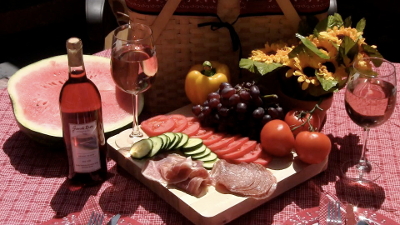 You can treat yourself in the frontcountry.
You can treat yourself in the frontcountry.When we’re camping in the frontcountry, our options for compiling a camping food list are almost endless, and, having access to great variety, we shouldn’t consign ourselves to mediocre table fare.
In addition to cars and roads, we have access to a few key resources in the frontcountry which significantly contribute to the variety of foods we can utilize. Namely, more complex and variable cooking equipment, and greater food storage capacity, specifically in the form of a cooler.
The first decision to make before putting together your camping food list is what kind of cooking you want to do. Basically the choice is between stove cooking and campfire cooking. Most people will generally opt for a combination of the two.
Stoves are incredibly convenient, and if you don’t already have one, I highly recommend picking one up. Stoves vary based on intended use and fuel type. The complexities of stove design are somewhat beyond the scope of this article, so I recommend doing further research before making a purchase, but multi-burner propane stoves are a good place to start for the frontcountry chef.
With access to a quality stove, we can do much of the same food prep in the woods that we would do at home, without having to go through the trouble of starting and maintaining a fire every time we’d like to cook anything.
Campfire cooking, on the other hand, has a rustic aesthetic and backwoods appeal that’s hard to surpass, but requires some mastery to perfect. Cooking over a fire is a fun social activity as well and can be an important part of many peoples enjoyment of a camping trip. I’d also like to point out that campfire cooking shouldn’t be limited to the roasting of skewered meat, and that the cast iron skillet is a great ally in the pursuit of haute cuisine in the outdoors.
 You can use a cast iron skillet to cook many items from corn bread to shakshuka over a fire.
You can use a cast iron skillet to cook many items from corn bread to shakshuka over a fire.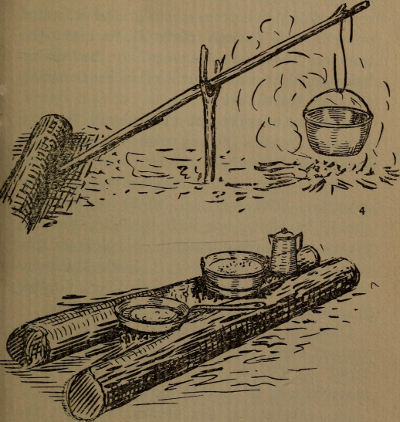 Campfire cooking can be much more that roasting weenies.
Campfire cooking can be much more that roasting weenies.My recommendation is to plan to do both kinds of cooking if possible. A good place to start is to plan for a breakfast using the stove, a lunch that requires little or no cooking, and a dinner which can be cooked over the fire.
Another great ally, the cooler, lets us bring in perishable foods to enrich our trips. Having access to raw meats, fresh vegetables, and dairy products drastically elevates the potential of our meals. If possible, I like to bring a big cooler and eat a lot of fresh foods.
With these things in mind we can start putting our camping food list together. Breaking your list down by meal makes the process simpler and more thorough.
An example meal plan could look something like this:
Breakfast – Classic American w/ coffee (cooked on propane stove)
• Pancake Mix
• Eggs
• Bacon
• Milk
• Olive Oil
• Butter
• Maple Syrup
• Salt / Pepper
• Hot Sauce
• Coffee
• Half and Half
• Sugar
Lunch – Big Tasty Sandwiches w/ Potato Chips (little or no cooking)
• Hoagie Rolls
• Deli Meat
• Cheese
• Tomatoes
• Onions
• Alfalfa Sprouts
• Mayonnaise
• Mustard
• Potato Chips (Ideally Jalapeño)
Snacks –
• Crackers
• Goat Cheese
• Hummus
• Salami
• Bell Peppers
• Cherry Tomatoes
• Trail Mix
Dinner – Sausage and Stir-fried Vegetables w/ Potato Salad (cooked over fire)
• Bratwurst
• Sauerkraut
• Kale
• Zucchini
• Onions
• Bell Peppers
• Garlic
• Salt / Spices
• Mustard
• Baked Beans
• Potato Salad
Other great foods to consider include:
• Sausage / Chorizo
• Hash browns
• Whole Potatoes
• Granola
• Yogurt
• Fresh Fruit
• Salad Greens
• Canned Foods (Soups / Chili)
• Pasta
• Hamburger (think burgers or sloppy joes)
• Kabobs
• Corn
• Anything you would BBQ at home
There are countless other foods appropriate for frontcountry prep, and you are essentially only limited by your creativity and motivation. As you become more experienced packing and cooking food in the outdoors, you can try new things, especially in regards to cooking over the fire. Think about what you like to eat at home and how you could make it with limited supplies.
Backcountry Camping Food List
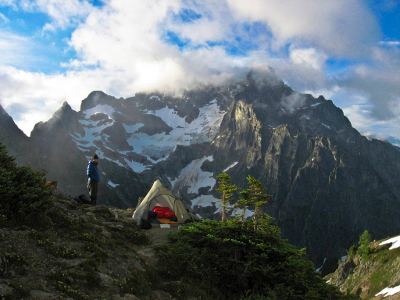 Options are more limited in the backcountry.
Options are more limited in the backcountry.Generating a backcountry camping food list can be a little bit trickier due to the specific logistics of backcountry travel. Fuel and cooking equipment are limited, and we have no way of preserving perishable foods.
Weight is a serious consideration and so too is proper rationing. That being said, a good meal in the wilderness can seem like nirvana after a long day on the trail, and a little forethought can go a long way toward making a trip enjoyable.
Because fuel is in limited supply, it is even more important to select foods that can be cooked quickly and simply. Dehydrated or freeze-dried foods are good choices; my goal is to do little more than boil water and combine ingredients.
Along these same lines, I try to make mostly one pot meals, meaning that I will cook everything in a single pot, using ingredients that can all be added to the pot in turn without the need for extra containers. I eat everything out of this same pot. Not only does this cut down on the weight of excess containers, it minimizes the hassle of cleaning dishes.
Be More Prepared For Your Next Outdoor Adventure!
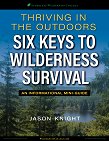
Don't leave home without knowing these six essential survival skills. Our free survival mini guide reveals the strategies of:
- Shelter & fire to prevent the number one cause of death
- Obtaining clean water to avoid life-threatening dehydration
- Common wild survival foods and other critical skills!

Dehydrated and freeze-dried foods also work to achieve the additional goal of reducing weight to a feasible minimum. Weight and space are primary limiting factors in the variety of foods you can bring with you into the backcountry. Canned chili, for example, could theoretically be a great backcountry food. It’s imperishable and takes little or no preparation to enjoy, but you won’t thank yourself for packing 10 lbs. of canned chili on a backpacking trip.
The same can be said for fresh fruits and vegetables. Not only are they perishable, but they’re big and heavy. While these are certainly enjoyable, and definitely missed, on a backpacking trip, the burden of carrying them is unjustifiable beyond the first day or so of a trip; sometimes I will carry fresh foods to make lunch or dinner my first day on the trail, but that’s about it.
Many foods also come with bulky packaging. I usually look for alternatives that save on space and weight. Tuna is a great example. The classic cans are bigger and heavier than I will usually want to carry, however we now have lightweight vacuum packs of tuna available which are much more reasonable. I usually also repackage my food. I’ll take things like pasta that come in big cardboard boxes and put them in Ziploc bags. Condiments and spices go in tiny bottles and squeeze tubes.
Rations must be watched more closely to make sure you are getting enough food without carrying unnecessary baggage. There are essentially two ways to do this; you can either pack prepared meals, or bulk foods.
Pre-planned meals are more straightforward and allow for meal logistics to be predominantly worked out prior to a trip. They also tend to be more lightweight and quicker to prepare, especially pre-packaged, freeze-dried meals like Mountain House.
Bulk foods tend to be more complex logistically and take somewhat more preparation, but provide more flexibility and allow for more creative meals. The heavier weight of bulk foods can also be compounded by the need for more cooking equipment, but this can be mitigated by spreading the load out amongst a group, and camaraderie of preparing and enjoying meals with bulk foods in a group setting is hard to beat.
Examples of bulk foods that work well in the backcountry include:
• Oatmeal
• Granola
• Dehydrated Milk
• Dehydrated eggs
• Flour / Baking Mix
• Sugar
• Coconut Oil
• Salami / Dried Meats
• Cheese
• Crackers
• Cookies (think Oreos etc.)
• Pasta
• Rice (especially instant)
• Rice Noodles
• Instant Potatoes
• Tomato Powder
• Trail Mix – Nuts/Raisins/Etc.
• Dried Fruits
• Couscous
• Instant Soup mix (Eg. Miso)
• Instant Beans / Lentils
• Instant Falafel
If relying on bulk rations, you will have to calculate how much to take by food weight consumed per day. I don’t want to dissect the complexities of meal planning too minutely here, but you will be looking at around 1.5 to 2.5 lbs. of food per day depending on exertion and climatic conditions.
In general I’ll take a hybrid approach, but for solo hikers or small groups, I recommend leaning toward prepared foods, and in a group setting leaning toward bulk foods. Pre-planned meals will also usually win out on shorter trips, whereas on longer excursions, or when canoes or stock and the associated equipment, come into play, bulk foods may be the way to go.
With these things in mind let’s look at another example camping food list. We’ll break it down meal by meal again and emphasize prepared foods.
Breakfast –
• Instant Oatmeal
• Dried Fruit
Lunch –
• Salami
• Cheese
• Crackers
Snacks –
• Power Bars
• Trail Mix (Peanuts, Raisins, M&M’s, Etc.)
Dinner –
• Macaroni & Cheese (Repackaged in Ziploc)
• Freeze Dried Peas
• Tuna (Vacuum Packed in Oil)
• Coconut Oil
• Dehydrated Milk
• Sriracha
Beverages –
• Instant Coffee
• Instant Sports Drink
• Hot Chocolate
It’s worth mentioning that some dedicated backcountry travelers striving for ultralight convenience will adopt a no-cook methodology. This entirely obviates the need for a stove, fuel, and even a metal pot by replacing cooking with cold soaking.
The basic method is to begin the day by mixing the ingredients of your dinner into your cold soak container and adding water. The most popular contemporary cold soak container is a pint sized plastic gelato tub with a screw lid. This container is sealed and carried in your pack. Lunch and snacks throughout the day are foods that don’t need to be cooked. At the end of the day simply open your cold soak container and eat the meal you prepared in the morning. After dinner, dump your breakfast into the cold soak container, add water and let it soak overnight. The routine begins again in the morning after breakfast when you throw your dinner in to cold soak
 This is the most popular cold-soaking container around.
This is the most popular cold-soaking container around.This is obviously a simplified run-down. You can also roll with 3 soaked meals by putting breakfast in overnight, lunch in after breakfast, and dinner in after lunch. If you want to try this method, I definitely suggest trying it out on a shorter, maybe overnight, trip to try to get all the bugs worked out and make sure it’s right for you.
The intricacies of crafting quality foods with a no-cook method are too extensive to include in this article but a few ideas for a no-cook camping food list include:
• Instant oatmeal
• Instant Mashed Potatoes
• Dehydrated Refried Beans
• Ramen
• Freeze-dried Meals (Mountain House, Backpacker’s Pantry, Etc.)
• Dehydrated Meats
• Dehydrated Fruits / Vegetables
• Instant Rice
• Couscous
• Dehydrated Milk
• Protein Shakes
• Chia Seeds
Regardless of whether you’re cooking or cold soaking, you have probably noticed that a number of backcountry staples are dehydrated meals. As you immerse yourself more in outdoor recreation, especially backpacking, I recommend looking in to dehydrating your own meals. Not only is it kind of fun, but it also allows you to diversify your trail diet and with some interesting and healthy custom made meals.
Don’t forget either that any time you are out and about you can use wild foods to augment your camping food list. When I’m out camping I’ll almost always harvest a few wild greens, berries, or mushrooms to perk up my meals. While this is, of course, another subject that is far beyond the scope of this article, it is also deeply rewarding in and of itself so further research is definitely warranted.
For those of you in the midst of planning a trip, I hope this article has been informative. Remember that you have a lot of options and you can really only figure out what you like by taking it out and trying it!
By the way, when you're spending more time in nature it's important to know how to stay safe in the outdoors, especially if you were to get lost. Right now you can get a free copy of our mini survival guide here, where you'll discover six key strategies for outdoor emergencies, plus often-overlooked survival tips.
Additional Resources:
If you want a more thorough exploration of food preservation or wild foods, check out some of our other articles, or if you really want to dive deep, check out our wilderness skills courses.
Camping Food List ideas from REI.

About the Author: Jedidiah Forsyth is an experienced outdoor educator and wildlife tracker. He is a guest instructor at Alderleaf Wilderness College. Learn more about Jedidiah Forsyth.
Return from Camping Food List back to Wilderness Skills Articles
Is The Essential Wilderness Survival Skills Course Right for You? Take the "Online Survival Training Readiness" Quiz
See for yourself if this eye-opening course is a good fit for you. It takes just a few minutes! Get your Survival Training Readiness Score Now!

Grow Your Outdoor Skills! Get monthly updates on new wilderness skills, upcoming courses, and special opportunities. Join the free Alderleaf eNews and as a welcome gift you'll get a copy of our Mini Survival Guide.

 The Six Keys to Survival: Get a free copy of our survival mini-guide and monthly tips!
The Six Keys to Survival: Get a free copy of our survival mini-guide and monthly tips!
Learn more